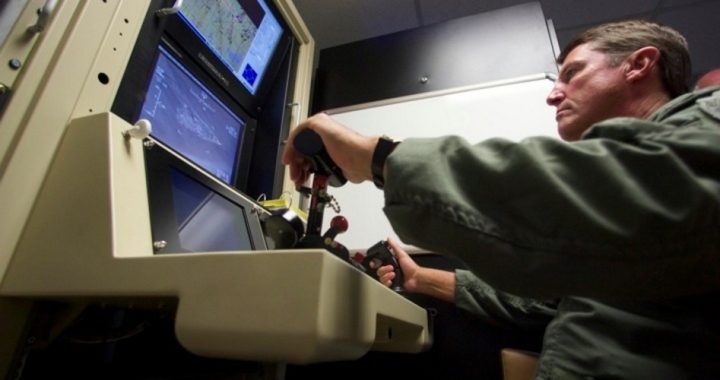
The U.S. Air Force is training more drone “pilots” than those who will be at the controls of traditional aircraft, according to the Air Force chief of staff.
To date, there are reportedly around 1,300 people controlling the Air Force’s arsenal of Reaper, Predator, and Global Hawk drones, and the Pentagon plans to add about 2,500 pilots and support crew by 2014, according to an article in published August 3 by The Times (of London).
The UK paper reports that 350 new drone pilots were trained in 2011 “compared to 250 conventional fighter and bomber pilots.”
The trend away from traditional pilots to drone “pilots” is evidenced at Holloman Air Force Base in New Mexico, where 360 drone crews will graduate this year. A crew includes a pilot, a sensory operator, and a mission coordinator.
A drone instructor working at the base was quoted in a British newspaper saying, “We’re getting the best and brightest.There’s a bright future for RPAs [remotely piloted aircraft] so we’re getting motivated, sharp guys.”
The instructor’s boss likes the way the operation is progressing. During his final press conference, U.S. Air Force Chief of Staff General Norton Schwartz described the future of air combat:
Manned aviation will be part of the chemistry because at least for the near term, the Remotely Piloted Aircraft (RPA) capability is not for contested airspace. It is a benign airspace capability.
When and if we’re challenged, manned aviation — F35s are a case in point, and B2s — will be part of our force structure, I would estimate, at least for a generation and a half. Thirty years probably — maybe more, probably not less.
We’re training more RPA (Remotely Piloted Aircraft) aviators than we are bomber and fighter pilots. Ultimately, it is conceivable that the majority of aviators in our Air Force will be Remotely Piloted Aircraft operators.
This news is no surprise to our readers as it only confirms the information The New American reported weeks ago regarding the programs being created in many colleges offering instruction on drone piloting.
One such institution, Eastern Gateway Community College, offers the following description of their intended use of drones:
The Eastern Gateway Community College (EGCC) intends to provide training in the operation of UAS [Unmanned Aircraft Systems] including the use and integration of UAS payload systems as a safe and effective tool for law enforcement, emergency responders and other government agencies.
EGCC is one of 30 Ohio community colleges and universities selected as sites for terrorism training under the Ohio Homeland Security Training Alliance. The EGCC UAS training program will be included as a course offered to emergency service professionals.
The EGCC UAS program will provide emergency service professionals access to standardized training which will include simulated UAS operations, scenario based flight training and best practices and procedures. As Emergency service administrators become more familiar with UAS applications, they will have access to relevant and practical training, reducing the need of individual COA requests.
Doubtless there will soon be similar classes appearing in college course catalogs promising to train students to operate the thousands of unmanned surveillance vehicles soon to be deployed in the skies over America. It seems that the government is set not only to provide grants to universities to fund the development of new and more powerful drones, but to teach students how to fly them once they are manufactured.
In other drone news, China is set to become the world’s largest vendor of the remote-control killing machines. The US-China Economic and Security Review Commission recently reported that China “has deployed several types of unmanned aerial vehicles for both reconnaissance and combat,” Similarly, a story in the Washington Post quoted Zhang Qiaoliang from the Chengdu Aircraft Design and Research Institute as saying, “the United States doesn’t export many attack drones, so we’re taking advantage of that hole in the market.”
For example, an arm of the Chinese communist government (Shenyang Aircraft Company) is working on the Anjian (Dark Sword), a supersonic unmanned fighter aircraft, “the first drone designed for aerial dogfights.”
Not to be outdone, the engineers at DARPA (the research and development group at the Department of Defense) are working on the HTV-2 (Hypersonic Technology Vehicle) program aimed at developing weaponized drones that can reach any point on Planet Earth within one hour. According to DARPA’s own report of the most recent test mission, ”The flight successfully demonstrated stable aerodynamically-controlled flight at speeds up to Mach 20 (20 times the speed of sound) for nearly three minutes.”
While such speed and technology is impressive, there is a very sinister side to such strides. As one writer at the Guardian commented, “The hypersonic fully autonomous drones of the future would create very powerful, effective, and flexible killing machines. The downside is that these machines will not be able to discriminate on their targets — there are no programmes capable of distinguishing civilian from combatant.”
British drone designers have recently introduced an unmanned aerial vehicle (UAV) that comes equipped with “lidar” (light detection and ranging), “remote-sensing technology that uses lasers to create detailed three-dimensional images which can be viewed from any angle.”
Basically, this drone would be capable of using this onboard laser to scan the interior of buildings that would otherwise be invisible to the naked eye or traditional airborne surveillance.
As one writer observed, “The model has potential military spin-offs. In Afghanistan, you could send it into [a] building and do a survey so you’d know who and what was inside.”
Of course, wary Americans realize that buildings in this country are as likely as those in Afghanistan to be scanned by the government’s all-powerful eye in the sky under the control of “pilots” trained by the military or at college to keep the drones airborne and to keep citizens under constant surveillance.
Photo: AP Images



